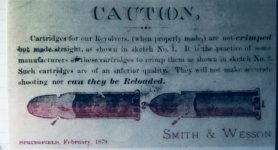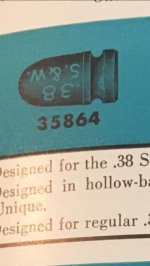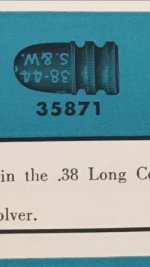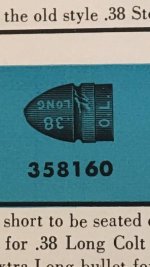You know, there is the Chicken Little approach and then there is testing and observation using research and data. Whichever approach used is up to you. Bottom line is that the "sky is not falling" for me. Remington, Winchester, and some European ammunition manufacturers are great sources for purchasing 38 S&W ammo. They only use soft lead bullets, and all I have ever tested are loaded below the original BP rounds.
I have been able to test almost all calibers that span the BP to smokeless eras, and have kept my information for future reference. The test results for 38 S&W ammo gives me a strong opinion that current standard loads are actually loaded with pressures below original BP loads.
First, soft lead is quite easy to determine, since a fingernail test will determine soft lead and all I have ever purchased will easily mark. Also, one can test a spent bullet and compare with known pure lead bullets and I have never found any differences.
Second, tested velocities show a large and consistent difference between original BP an smokeless factory loads. Averaging velocity tests on both original BP loads and current standard 38 Special commercial loading yields about a 20% to 30% reduction in velocities using "modern" ammo.
Remington 145g LRN Factory BP. . . . . . . . . 748 fps
Remington 145g LRN Factory Smokeless . . . 537fps
Winchester 145g LRN Factory BP. . . . . . . . . 685fps
Winchester 145g LRN Factory Smokeless. . . 615fps
PPU 145g LRN Factory Smokeless. . . . . . . . 599fps
Reloads 145 LRN 15g 4F BP . . . . . . . . . . . .720fps
Always using the same S&W 38 DA, 5" barrel revolver for tests over the years, give a relative account of felt recoil. BP offers a consistently higher felt recoil than smokeless. Higher felt recoil and 20%+ slower velocities, help me make the decision that current smokeless loads provide less pressure and stress on the gun than original BP. Add in the near infinite possibilities of reloading with lighter bullets and different powders, you can definitely come up with even lower pressure loads that will still punch round holes in paper. Don't get me wrong, there is at least one manufactured round out there today that should not be shot in a top-break revolver. There have been reports of a manufacturer loading ammo capable of over 1000 fps, but I have not seen it, so know what you are buying. Safe thing is to stick with standard 145g RN ammo from Remington, PPU, Fiocchi, and Winchester.
Third, steel yield strengths in the late 1800s were far more than adequate to withstand the pressures of 38 S&W loads made today or over a hundred years ago. Besides, it is not so much the strength of steel that dictates the maximum pressures for a top-break revolver, but rather their basic design using a hinged frame and a small top-latch limits pressures. Solid frame revolvers are much stronger and can withstand more pressure, but ammunition manufacturers still design for the top-break as the standard because people are still shooting top-breaks and liability issues will always remain the driving force in their design and production.
Lastly, steel yield strengths are often used to say that steel made in the late 1890s and early 1900s was far inferior to that available by say WWII era. Totally untrue and mostly irrelevant to this discussion. By the 1890s, high grade steel was available in yield-strengths of 50,000 psi and steel from the WWII era increased to 60,000 psi. Considering the fact that 38 S&W top-break revolvers maximum pressures were 13,000 psi, you can draw your own conclusions.
I always supply the caveat that any 100+ year old S&W can break shooting any type of ammo, but if the revolver is in fine mechanical condition, it will be most likely springs, internal parts, etc. that can fail, not the revolver itself. I always advise new shooters that parts for these vintage guns can be a real challenge to find. Having shot thousands of rounds of 38 S&W through dozens of S&W top-breaks over the last few decades gives me great comfort in grabbing the next one in line and heading for the range today. I have to say that no broken parts in any of these little beauties yet.





